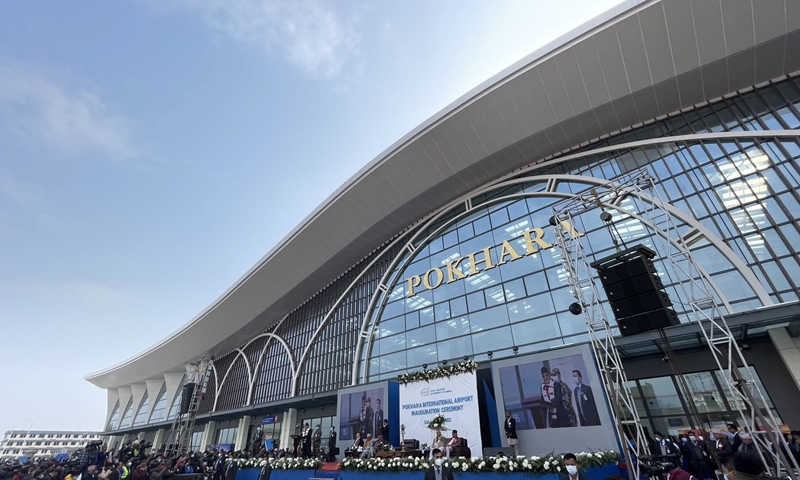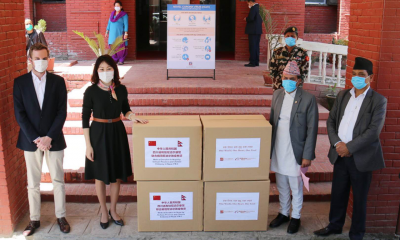Nepal and China Will Enhance Connectivity and Development Through High-Quality BRI Cooperation

The BRI has evolved into a global platform where participating countries join hands to improve people’s livelihoods and drive human development forward, despite the various challenges facing the world.
Nepal and China reaffirmed their commitments to pursue deeper and even more concrete high-quality Belt and Road cooperation during the visit of Nepal’s Prime Minister KP Sharma Oli to China from December 2 to 5. Oli pays the four-day official visit to the northern neighbor at the invitation of his counterpart Li Qiang. This is Oli’s first bilateral visit to a neighboring country since he returned to power in July 2024.
The two friendly neighboring countries expressed their commitment to strengthening connectivity between the two countries in such areas as ports, roads, railways, aviation, power grids and telecommunication, to help Nepal transform from a land-locked country to a land-linked country.
Nepal joined the Belt and Road Initiative (BRI) on May 12, 2017. Since then, the Nepal-China practical cooperation has been further enhanced both in quality and efficiency. Chinese President Xi Jinping envisioned the BRI as a framework connecting countries around the world through trade, investment, infrastructure development, finance and people-to-people exchanges, among others.
As of now, the BRI has achieved far more than physical connectivity. With the spirit of extensive consultation, joint contribution and shared benefits, the BRI has evolved into a global platform where participating countries join hands to improve people’s livelihoods and drive human development forward, despite the various challenges facing the world.
Over the past decade, the BRI has delivered a slew of practical projects worldwide, bringing tangible benefits to millions of people. The BRI has seen growing partnerships around the world. So far, more than 150 countries and over 30 international organizations have signed BRI cooperation agreements, with the initiative extending from the Eurasian continent to Africa and Latin America.

China-Nepal railway project under BRI
Some projects under the BRI have already been launched while some projects are expected to take years to be completed. The China-Nepal cross-border railway is one of the long-term projects. The two countries have reaffirmed their commitment to push forward with the railway project during Prime Minister Oli’s China visit.
“The two sides expressed willingness to steadily advance the feasibility study of the Jilong-Kathmandu Cross-Border Railway, and planned to hold the ninth Working Meeting on China-Nepal Railway Cooperation. The Chinese side will continue to help Nepal train professionals in the field of railway,” read the joint statement issued during the visit.
To enhance cross-border railroad connectivity, Nepal and China announced the launch of a feasibility study of the China-Nepal cross-border railway when Chinese President Xi Jinping paid a historic visit to Nepal in October 2019. The Nepal-China railway is one of the key projects under the BRI and the feasibility study for the railway project is currently underway. China has provided grant assistance to support the feasibility study of the cross-border railway project and sent its railway experts to conduct the field survey work since 2022. There are several advantages for Nepal upon the completion of the railway.
On the one hand, the cross-border connectivity between the two countries will be enhanced by minimizing the time and cost; On the other hand, it will maximize the volume of bilateral trade and investment. The railway will help bring excellent Nepali goods such as cashmere fabrics, wood products, handicrafts, and organic alpine agricultural products to China while transferring China’s technological development to Nepal. That is why the China-Nepal railway project carries huge expectations of the two peoples.
Surya Raj Acharya, a Nepali infrastructure expert, believes that the railway will be a game-changer for Nepal’s economic development after its completion. “The construction of Nepal-China railway will also be a boon for Nepal. We have seen in many BRI partnering countries that it has improved infrastructure and connectivity, created tens of thousands of jobs, and helped countries realize their shared vision of peaceful development, win-win cooperation, and common prosperity,” Acharya said.
Further aviation cooperation
During Oli’s visit, the two sides also agreed to increase cooperation in civil aviation under the BRI. “The two sides value the development of civil aviation ties between China and Nepal, and support and encourage air transport enterprises of both sides to open air routes and flights between Chinese cities and Nepali cities such as Pokhara and Lumbini in light of market demand, so as to facilitate bilateral economic and trade ties and two-way travel,” read the joint statement.
The inauguration of the China-aided international airport in Nepal’s tourist city Pokhara was one of the greatest moments for many Nepali people. The project, an integral part of the China-Nepal Belt and Road cooperation, was inaugurated in December 2022. Envisaged more than 59 years ago, the international airport is now becoming a boost to the local economy.
Since the opening of the airport, it has successfully completed the domestic shipping task, and a new charter flight opened a new avenue in China-Nepal cooperation under the BRI. The Pokhara airport, a 4D-standard facility, was contracted with loan from the Export-Import Bank of China (China EXIM Bank) by China CAMC Engineering Co., Ltd., a company directly affiliated with China National Machinery Industry Corporation which ranks among the top 500 enterprises in the world. The construction started in July 2017, two months after Nepal became a BRI partner country. The airport demonstrated China’s pursuit of quality in project construction and marked Nepal’s national pride.

Cross-border energy cooperation
Apart from railroad and aviation connectivity, Nepal and China have also been working to seek collaboration in the field of energy. Nepal is rich in water resources and willing to sell its surplus electricity to China in near future. China has expressed readiness to support Nepal in this regard.
During the visit of the Prime Minister, the two sides also reiterated commitment towards this end. “The two sides will continue to leverage the platform of the China-Nepal Energy Joint Implementation Mechanism, deepen cooperation in energy and explore exchanges in new energy. The two sides are ready to expedite the feasibility study of the China-aided Jilong-Rasuwagadhi-Chilime 220KV Cross-Border Power Transmission Line. The two sides agreed to continue to support the cooperation between telecommunication operators of the two countries and to carry out maintenance and expansion projects related to cross-border land cables,” read the joint statement.
Future opportunities for Nepal
Nepal can learn the experience from Asian countries which have already successfully completed BRI projects and boosted their economies. The Jakarta-Bandung High-Speed Railway is one of such examples. The railway is a flagship project that dovetails the BRI with Indonesia’s Global Maritime Fulcrum. For the past year since the high-speed train went into operation, the project has seen comprehensive collaboration of teams from both countries in areas such as high-speed rail operation management, talent development and technology transfer.
The BRI is seen as a great opportunity for Nepal as it aspires to become a ‘dynamic bridge’ between China and India by developing North-South transport corridors. In the words of Kalyan Raj Sharma, a close observer of Nepal-China relations, BRI presents a strategic opportunity for Nepal to advance development projects as there is a lack of vital infrastructure.
Analysts believe that BRI could be a boon for low-income and middle-income countries like Nepal which are constrained by limited financial resources and looking for foreign investment to meet the development needs.
“For many low- and middle-income countries constrained by limited financial resources, the BRI offers a potential pathway to realize ambitious development goals, paralleling China’s rapid growth trajectory of recent decades,” Kalyan Raj Sharma said in his recent article. He opined that Nepal can take advantage of China’s expertise in rapid economic growth and infrastructure construction by approaching the BRI as a nuanced, multidimensional initiative.
The article reflects the author’s opinions, and not necessarily the views of China Focus.
 Facebook
Facebook
 Twitter
Twitter
 Linkedin
Linkedin
 Google +
Google +






